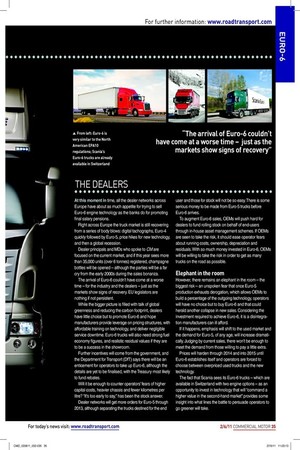THE DEALERS
Page 32

If you've noticed an error in this article please click here to report it so we can fix it.
At this moment in time, all the dealer networks across Europe have about as much appetite for trying to sell Euro-6 engine technology as the banks do for promoting final salary pensions.
Right across Europe the truck market is still recovering from a series of body blows: digital tachographs, Euro-4 quickly followed by Euro-5, price hikes for new technology, and then a global recession.
Dealer principals and MDs who spoke to CM are focused on the current market, and if this year sees more than 35,000 units (over 6 tonnes) registered, champagne bottles will be opened – although the parties will be a far cry from the early 2000s during the sales bonanza.
The arrival of Euro-6 couldn’t have come at a worse time – for the industry and the dealers – just as the markets show signs of recovery. EU legislators are nothing if not persistent.
While the bigger picture is filled with talk of global greenness and reducing the carbon footprint, dealers have little choice but to promote Euro-6 and hope manufacturers provide leverage on pricing structures, with affordable training on technology, and deliver negligible service downtime. Euro-6 trucks will also need strong fuel economy figures, and realistic residual values if they are to be a success in the showroom.
Further incentives will come from the government, and the Department for Transport (DfT) says there will be an enticement for operators to take up Euro-6, although the details are yet to be finalised, with the Treasury most likely to fund rebates.
Will it be enough to counter operators’ fears of higher capital costs, heavier chassis and fewer kilometres per litre? “It’s too early to say, ” has been the stock answer.
Dealer networks will get more orders for Euro-5 through 2013, although separating the trucks destined for the end user and those for stock will not be so easy. There is some serious money to be made from Euro-5 trucks before Euro-6 arrives.
To augment Euro-6 sales, OEMs will push hard for dealers to fund rolling stock on behalf of end-users through in-house asset management schemes. If OEMs are seen to take the risk, it should ease operator fears about running costs, ownership, depreciation and residuals. With so much money invested in Euro-6, OEMs will be willing to take the risk in order to get as many trucks on the road as possible.
Elephant in the room
However, there remains an elephant in the room – the biggest risk – an unspoken fear that once Euro-5 production exhausts derogation, which allows OEMs to build a percentage of the outgoing technology, operators will have no choice but to buy Euro-6 and that could herald another collapse in new sales. Considering the investment required to achieve Euro-6, it is a disintegration manufacturers can ill afford.
If it happens, emphasis will shift to the used market and the demand for Euro-5, of any age, will increase dramatically. Judging by current sales, there won’t be enough to meet the demand from those willing to pay a little extra.
Prices will harden through 2014 and into 2015 until Euro-6 establishes itself and operators are forced to choose between overpriced used trucks and the new technology.
The fact that Scania sees its Euro-6 trucks – which are available in Switzerland with two engine options – as an opportunity to invest in technology that will “command a higher value in the second-hand market” provides some insight into what lines the battle to persuade operators to go greener will take.














































